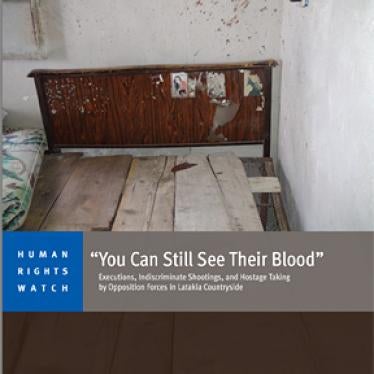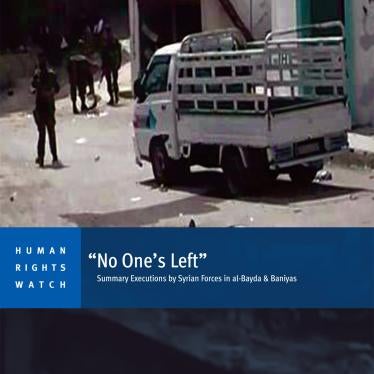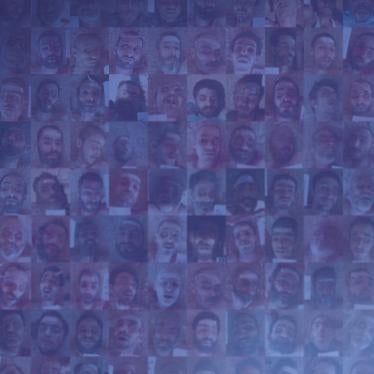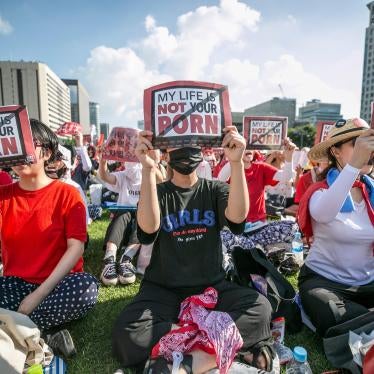(New York) – The Syrian government should immediately stop its shelling of residential neighborhoods in the city of Homs, Human Rights Watch said today. Since February 3, 2012, the attacks have killed more than 300 persons in the city, according to Syrian monitoring groups, and wounded hundreds others, including women and children. No adequate medical assistance is available to the victims due to a blockade of the city by government forces and fear of arrest if treated at government-controlled hospitals, Human Rights Watch said.
Eight witnesses to the attacks interviewed by Human Rights Watch said that government troops have fired hundreds of “shells and mortars” into populated neighborhoods. Videos and photos of the attacks, reviewed by Human Rights Watch’s arms experts, and accounts from international journalists on the ground, confirm that government forces launched long-range indirect fire attacks into densely populated areas.
“This brutal assault on residential neighborhoods shows the Syrian authorities’ contempt for the lives of their citizens in Homs,” said Anna Neistat, associate emergencies director at Human Rights Watch. “Those responsible for such horrific attacks will have to answer for them.”
Witnesses told Human Rights Watch that government forces launched large-scale attacks, involving shelling and rockets, on several neighborhoods in Homs on the evening of February 3. “Hani,” a witness from the Bab `Amro neighborhood, said that security forces manning nearby checkpoints and positioned on rooftops first opened fire on a protest near Al-Zahire mosque at around 6 pm, and shortly thereafter started shelling the neighborhood. Hani, who sustained bullet wounds to his left shoulder and right leg in the attack, said that Syrian forces fired rockets from the west and from the direction of Homs University dorms located to the south-east of Bab `Amro.
Another witness, “Wasim,” who spoke to Human Rights Watch from Tel al-Shoghour area, located close to Bab `Amro, said that the shelling of Bab `Amro originated from neighboring areas considered to support the government of President Bashar al-Assad. The fire, according to Wasim, also came from the Homs University dorms, about 1,500 meters south-east of Bab `Amro; and Insha’at neighborhood, north of Bab `Amro.
“Samer,” a witness to the attack on the Khalidiyya neighborhood in the evening of February 3, told Human Rights Watch that the attack started after the Free Syrian Army attacked and took over a security checkpoint connecting Khalidiyya and Bayyada neighborhoods in Homs and residents of Khalidiyya went to the streets to celebrate. “Samer” said that around 9.30 pm government forces started intensive shelling of the neighborhood that lasted for several hours. According to the witness, the fire came from the direction of the Air Force Intelligence facility located on the highway leading to Hama, some 500 meters from Khalidiyya. The security forces, according to the witness, used mortars to attack the neighborhood.
Since then, according to witnesses, the intensive shelling continued unabated, targeting Khalidiyya, Bayyada, Naziheen, Rifai and Bab `Amro neighborhoods in and around Homs. “Khaled”, who spoke to Human Rights Watch from Insha’at neighborhood in Homs said that, judging by the fragments of ammunition, the government forces used mortars and Shilka self-propelled anti-aircraft weapon systems. He confirmed that some of the attacks came from the direction of the Homs University dorms (about 3km south of Khalidiyya), taken over by the Syrian security forces.
These and other witness accounts, as well as video footage from Homs reviewed by Human Rights Watch’s arms experts, suggest that Syrian government forces were using long-range indirect fire weapons, which are inherently indiscriminate when fired into densely populated areas. The witness accounts were corroborated by international journalists present in the city during the attacks.
The exact casualty numbers are impossible to verify: due to heavy shelling, residents are not able to move around and most lines of communication are cut. According to the Violations Documentation Center (VDC), a Syrian monitoring group, 288 people were killed from February 3 to 8 in Homs. One witness, who had been collecting the names of the victims, provided Human Rights Watch with lists containing the names of 95 people reportedly killed on February 6 alone, 61 of them in Bab `Amro. The VDC’s list contains only 14 names of victims from Bab ’Amro. The witness said that out of the 95 victims, 11 were children, seven were women, and one was a military defector.
According to witnesses, several makeshift hospitals set up in the neighborhoods were overflowing with dead and wounded after the shelling. Medical staff in the areas quickly ran out of medical supplies, and at least three field hospitals were hit by the shelling, which contributed to the rising death toll.
“Karim”, a resident of Khalidiyya neighborhood, told Human Rights Watch in the morning of February 4, as the assault on the city continued:
I just came from the field hospital. There are three large rooms full of corpses. I’ve seen over 100 corpses today. Injured people are dying because we cannot treat them. There are still people in the street who are injured. They are missing body parts. We cannot pull them in because of the shooting. They will die in the street.
Wasim said that on February 6, the neighborhoods of Bab `Amro, Khalidiyya and Wadi Iran (now referred to by antigovernment protesters as Wadi Arab) were subjected to intensive shelling. Wasim was part of a group that tried to rescue some of the wounded from Bab `Amro that day. But all of those they were trying to assist died from blood loss and injuries when the rescue group came under fire while leaving the neighborhood and had to hide:
The shelling was every 15 minutes. Yesterday [February 6], my friends and I went to the entrance of Bab `Amro to try to transfer the wounded to a field hospital outside Bab `Amro. The biggest field hospital, which we worked really hard on setting up with medical equipment and supplies, was partly destroyed during the shelling. I could hear the sound of women and children screaming while running on the streets trying to escape the shelling. It wasn’t the first time I hear such sounds but on Monday the situation was worst due to the non-stop intensive shelling.
Finally we were able to rescue 10 wounded people, ages 14 to 50. We tried using secret passages that security forces supposedly don’t know about but as soon as we were about to move forward we came under short-range shooting. We couldn’t go anywhere; we had to stay in hiding while security forces were shooting at us. The 10 people died in our hands because they had head and neck injuries and needed urgent assistance.
Another witness, Khaled, said that in his neighborhood, Insha’at, the Al-Hikmi hospital, which was treating the wounded, was severely damaged when the area came under artillery attack on the morning of February 6, and at least one person died in the hospital as a result. Khaled said the shelling came from the direction of the Homs university dorms. He said that around 9am that day, a helicopter flew over the area and “officers in the helicopter were shooting at civilians with automatic weapons. They would shoot for 15 minutes then leave and come back, until they left the area at around noon.”
At the request of Human Rights Watch, Wasim contacted one of the doctors in Al Waer hospital; he said that, according to the doctor, the medical staff are desperate because they have run out of medical supplies and cannot help the wounded. The doctor told him that on February 7, 18 wounded patients, including a 13-year-old child, died of complications in the hospital when the electricity was cut off and the doctors could not provide them with adequate care. On February 8, the humanitarian organization Médecins Sans Frontières issued a statement condemning the security forces’ crackdown on the provision of urgent medical care for people wounded in the violence.
Other witnesses confirmed that the humanitarian situation in the city is dire. Homs residents are not able to leave the areas under attack, and experience acute deficit of food and medical supplies. “Mahmud,” a resident of Bab `Amro neighborhood, told Human Rights Watch:
There is no escape or safe passage from the area and there is no safe shelter inside the area from the rockets and shells. There is no bread, no medication and no nutritional supplies, and after a field hospital was targeted, we lost several of our medical staff. There is no form of communication inside the area and any moving object is targeted by snipers surrounding the area. Many of the wounded have very serious injuries – they lost their limbs, or eyes, had serious wounds to the body. They are in critical condition and are likely to die because there are no medical supplies to treat them properly.
The Free Syrian Army (FSA) forces, which consist mainly of low-ranking soldiers who had defected from the Syrian army, had earlier this year taken several neighborhoods in Homs under their control, and launched attacks on the Syrian military. One of the video clips from the area, for example, shows FSA soldiers setting an armored vehicle on fire. One witness, “Khaled,” told Human Rights Watch that FSA soldiers, estimated by various witnesses as ranging from a few hundred to 2,000 people in Homs, controlled a few neighborhoods inside Homs, while the city remained surrounded by government forces. Mani, a French photographer based in Homs, reported that the FSA attacked two other positions of the security forces in Bayyada on the night of February 5.
Indiscriminate shelling of populated areas which results in multiple civilian casualties constitutes a serious human rights violation. The situation is aggravated by the blockade of the areas under attack which prevents the residents, included those wounded by the attacks, from getting access to food and medical treatment.
The Syrian government launched the attacks as the United Nations Security Council debated a resolution condemning Syria’s 10-month-long crackdown on anti-government protesters. In a widely criticized move, Russia and China vetoed the resolution on February 4, blocking the Security Council from taking action on the crisis in Syria.
“It is clear the Syrian government has interpreted the Russia-China veto as a carte blanche to launch an all-out assault on cities like Homs without caring who’s killed in the process,” Neistat said. “Russia and China now have a particular responsibility to force the Syrian government to end its onslaught. If they can’t do that, they should stop obstructing Security Council action.”





